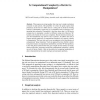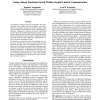SIGECOM
2008
ACM
14 years 1 months ago
2008
ACM
We introduce a class of voting rules called generalized scoring rules. Under such a rule, each vote generates a vector of k scores, and the outcome of the voting rule is based onl...
CORR
2010
Springer
14 years 1 months ago
2010
Springer
One possible escape from the Gibbard-Satterthwaite theorem is computational complexity. For example, it is NP-hard to compute if the STV rule can be manipulated. However, there is...
CLIMA
2010
14 years 2 months ago
2010
When agents are acting together, they may need a simple mechanism to decide on joint actions. One possibility is to have the agents express their preferences in the form of a ballo...
ECAI
2010
Springer
14 years 2 months ago
2010
Springer
Abstract. Voting is a simple mechanism to combine together the preferences of multiple agents. Agents may try to manipulate the result of voting by mis-reporting their preferences....
IJCAI
2007
14 years 3 months ago
2007
Voting rules map collections of preference orderings over a set of candidates (one for each voter) to candidates. Now, in many contexts, we have to consider the case where either t...
DAGSTUHL
2007
14 years 3 months ago
2007
A (randomized, anonymous) voting rule maps any multiset of total orders (aka. votes) over a fixed set of alternatives to a probability distribution over these alternatives. A voti...
AAAI
2010
14 years 3 months ago
2010
The concept of distance rationalizability allows one to define new voting rules or "rationalize" existing ones via a consensus class of elections and a distance. A conse...
AAAI
2010
14 years 3 months ago
2010
The Gibbard-Satterthwaite Theorem asserts that any reasonable voting rule cannot be strategyproof. A large body of research in AI deals with circumventing this theorem via computa...
AAAI
2010
14 years 3 months ago
2010
We consider settings in which voters vote in sequence, each voter knows the votes of the earlier voters and the preferences of the later voters, and voters are strategic. This can...
AAAI
2010
14 years 3 months ago
2010
In cooperative multiagent systems an alternative that maximizes the social welfare--the sum of utilities--can only be selected if each agent reports its full utility function. Thi...



